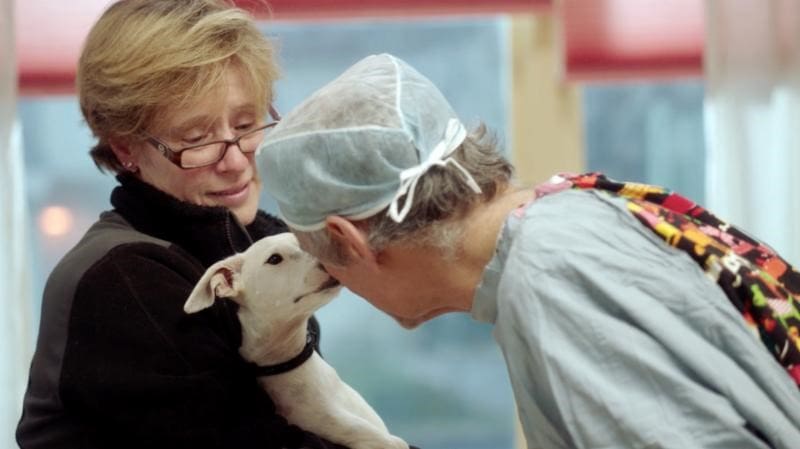
Before walking into director Cindy Meehl’s new documentary, The Dog Doc, which premiered at Tribeca this afternoon, you might wonder: does the dog die at the end? It seems likely considering the titular veterinarian, Dr. Marty Goldstein, specializes in last-chance cases at Smith Ridge, the facility he owns and operates in South Salem, New York. It’s an easy question to answer and while it’s hard to think of a documentary as something that could even be spoiled, answering that question would be like spoiling an episode of House or E.R.
After his own feelings of illness and weakness post-Cornell led to a doctor telling him the only way to heal was to take steroids and antibiotics, Goldstein sought out homeopathic remedies. After those methods helped him get better, he applied what he learned about nutrition and holistic medicine to his “patients” and became an “integrative veterinarian.” While that description immediately conjures phrases like “snake oil salesman” and “charlatan”–all things Goldstein has been called in print–Meehl expertly refutes those accusations throughout the film.
Mostly, she does that through following individual dogs through their treatments with Goldstein or the various doctors at Smith Ridge. Chief among them is Waffles, a 12-week-old puppy owned by Leigh Hardisty. With his tiny frame and preternatural awareness of the camera it is easy to fall in love with Waffles and the audience and Dr. Jacqueline Ruskin, who mostly handles his treatment, quickly do. A large part of Goldstein’s approach to healing is relying on supplements over traditional medicine to not only solve issues, but prevent them. So, it’s stunning to watch Waffles rebound after 3 days of a Vitamin C therapy that Goldstein pioneered.
Indeed, there and throughout, the effect of Goldstein’s treatments on the dogs Meehl follows border on miraculous and both his colleagues and friends repeatedly sing his praises. Where one fellow vet who originally visited Smith Ridge to try to get Goldstein’s license revoked describes literally fainting when Goldstein got a paralyzed dog to walk again after administering acupuncture, even more convincing (though less amusing) is his use of cryosurgery to deal with cancer.
As Dr. Randie Shane, who works at Smith Ridge, says when she first heard about the treatment, it sounded “barbaric.” Essentially, Goldstein uses liquid nitrogen to kill off the tumors, essentially creating necrotic tissue that the healthy tissue rejects. It’s frankly insane to watch. It is not a “sterile” surgery, as Goldstein describes it, and as one of Scooby’s owners says of being told not to clean the wounds, everything about it goes against conventional wisdom. And yet the result is undeniable: Scooby is still alive a year after another vet gave him two months to live.
However, while how well Goldstein methods can work for animals is evident on the screen, where the film runs into trouble is when it begs the question about how Goldstein’s methods could apply to humans. Admittedly, Meehl never directly addresses the issue and Goldstein himself never really draws the line from the animals back to himself. Goldstein wonders aloud why cryo therapy isn’t used in every “hospital” in the United States, but it’s unclear whether he’s specifically referring to animal hospitals. Instead, it’s over the issue of vaccines where the discussion gets a little touchy.
As Goldstein repeatedly emphasizes, he is not anti-vaccination. Rather, he argues that most state laws regulating vaccinations lead to animals being over-vaccinated. And while having an excess of immunity to rabies or parvo seems harmless, Goldstein makes the extraordinary claim that the chemicals called “adjuvants” that cause inflammation at the injection site to promote absorption of the vaccine are actually causing increased rates of cancer.
It’s quite a claim and one that a human already suspicious of vaccines could misconstrue. And while nothing about what we’ve seen of Goldstein’s work up to that point would suggest that he doesn’t have the research to back it up, the way the film is structured predisposes the viewer from questioning. The criticism we hear from Goldstein’s detractors is all at the beginning and with a few devastating exceptions, we’ve seen his methods produce miracles through much of the film.
Still, despite Meehl’s presentation leaving the possibility for a few dumb humans to make some logical leaps, The Dog Doc is ultimately enjoyable and informative. It is gratifying to see a group of hardworking professionals like the employees of Smith Ridge doing everything they can to keep innocent animals from suffering. As Goldstein himself says, he and the other veterinarians may not be able to save every animal, but they can give them a better quality of life while they have it and if doing so happens to extend that life too, then how can it not be a success?

